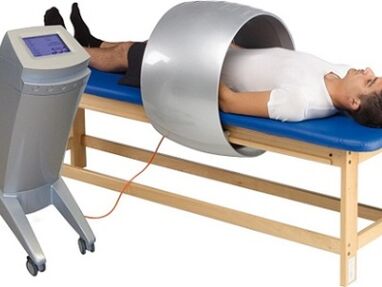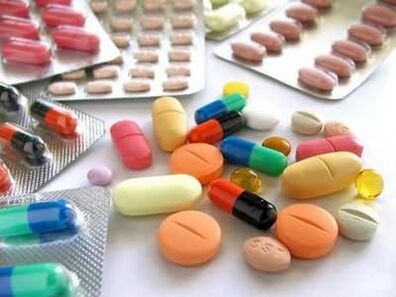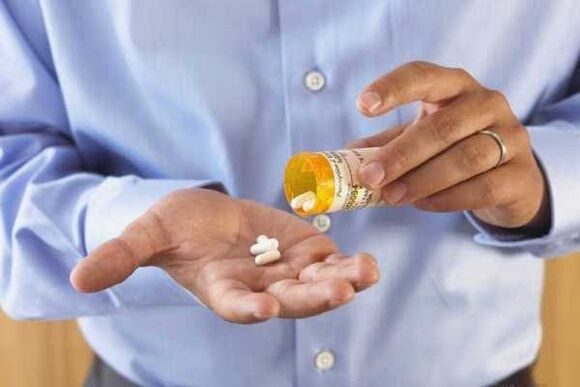Prostatitis is one of the most common diseases in men.At any stage, the pathology causes enormous discomfort and significantly worsens overall health.Drug treatment for prostatitis can effectively combat the disease.But to do it correctly and safely, you need to consult a doctor.
Existing treatments

In the treatment of prostatitis, several methods of therapy are used.The choice always depends on the nature and severity of the disease.There are ways to get rid of prostatitis:
- medicinal;
- surgical;
- physiotherapeutic.
Pay attention!Often, traditional medicine methods are also used at home.
This includes herbal baths and compresses.However, this therapy has extremely low efficacy and can only be used as an auxiliary therapy.
Usually prostatitis is treated comprehensively.In this case, drug therapy and one or several minimally invasive therapy methods are used simultaneously.Surgical intervention is used only in extremely serious cases, if other methods are ineffective.
Medication
Drug treatment of the prostate is used for any severity of the disease and covers different manifestations of the pathology.Additionally, some medications can be used as prophylactic drugs.Medications are also used during the surgical method as maintenance therapy.
The main purpose of using medications is to alleviate the inflammatory process, as well as eliminate the infection in bacterial prostatitis.Also, during complex drug therapy, medications help to normalize the functioning of the gland.
Surgical
The surgical method of therapy does not always mean radical measures that involve removing the gland.Safe and minimally invasive surgical methods are gaining prominence.
Surgical methods include:
- TUR (transurethal gland resection).It is performed using a resectoscope.Depending on the nature of the inflammation, part of the gland or the entire prostate may be removed during the procedure.
- Adenectomy or prostatectomy.Open surgery involving the use of a conventional scalpel.The procedure is characterized by a long rehabilitation period.
- Cryodestruction.The inflamed area of the gland is exposed to liquid nitrogen.
- Laser therapy.Mainly used for chronic prostatitis.Using a laser beam, moisture evaporates in the inflamed area of the gland.In this case, damaged tissues are burned.The method helps to improve the regenerative properties of the organ.
The choice of a specific method of surgical intervention is made individually, depending on the severity of the disease and the general condition of the body.
Physiotherapist

Physiotherapeutic methods include the following manipulations:
- Transuretal microwave therapy.It involves exposing the prostate to high temperatures.This is done using special external or invasive devices.During treatment, excess fluid from the organ evaporates and decreases in size, thus reducing pressure on the bladder.
- Exposure to ultrasonic waves.Treatment is carried out using special devices that allow you to influence exclusively the prostate gland.The therapy is painless.
- Inductotherapy with magnetic laser.It involves simultaneous exposure of the inflamed gland to laser and magnetic waves.The method allows you to alleviate pain symptoms, increase blood circulation in the organ and also accelerate tissue regeneration processes.The method also increases the effectiveness of the medicines used.
- Balloon dilation.A small dilator with an inflatable balloon at the end is inserted into the urethra.The device protects the bladder and excretory tract from increased prostate pressure on them.
- Stent.A stent is inserted into the urethra to protect the ducts from being squeezed by the growing gland.
- Reflexology.The method includes acupuncture and electropuncture.As a result of the procedures, blood circulation in the organ improves significantly, as well as metabolism and cell regeneration are accelerated.
- Hirudotherapy.It can only be carried out using medicinal leeches.Increased blood flow in the gland is guaranteed.
- Massage.The procedure allows you to increase blood circulation and metabolism.Massage also eliminates stagnation of gland secretions and increases the effectiveness of medications.
Physiotherapeutic methods of therapy are always used as a complement to drug treatment of the prostate.
Main groups of drugs
Drug treatment of prostatitis includes several groups of medications.These include:

- antibacterial agents;
- nonsteroidal anti-inflammatory drugs;
- antispasmodics or muscle relaxants;
- alpha-blockers;
- immunomodulators;
- analgesics;
- hormones;
- peptides or biological regulators;
- sedatives or anxiolytic medications.
Medicines from several groups are always prescribed at the same time.This is necessary not only to alleviate the symptoms of the pathology, but at the same time to eliminate the main cause of the disease and normalize the functioning of the organ.
Medications may come in the form of tablets, intramuscular injections, ointments, creams, or rectal suppositories.
Antibacterial agents
Antibacterial drugs, or antibiotics, are used to destroy pathological bacteria, the growth of which has provoked an inflammatory process in the gland.
The standard course of medication is 3 weeks.But taking antibiotics leads to disruption of the microflora of the gastrointestinal tract.Therefore, they can only be used after confirming the presence of a viral infection in tests.
Nonsteroidal anti-inflammatory drugs
Medicines in this group are used when the main cause of prostatitis is not a bacterial infection.
Additionally, non-steroidal anti-inflammatory drugs may be prescribed in case of low antibiotic effectiveness.
Since medications of this type have a negative effect on the liver and stomach, they cannot be used continuously for more than 3-5 days.
The greatest effectiveness of medications is observed when they are used at the beginning of the treatment of exacerbations.
Antispasmodics or muscle relaxants
Used for emergency relief of muscle spasms during an exacerbation of prostatitis, accompanied by prolonged urinary retention.
Medicines have a quick but short-lasting effect.
Alpha blockers
Medicines help restore the body's excretory function, relieving muscle spasm.
The course of continuous use is 7-8 months, as the drugs have cumulative effectiveness.
Immunomodulators
They are used for general strengthening of the body, as well as increasing its resistance to various infections.
Medications are necessary when using antibiotics.
Painkillers
Inflammatory processes in the prostate are always accompanied by pain.In this case, discomfort can occur both during urination, or erection, and at rest.
Medicinal microenemas have greater effectiveness and minimal side effects.
Hormones
Medicines of this type can only be used as prescribed by a doctor and when the cause of prostatitis is a hormonal imbalance in the male body.
Hormonal drugs are often prescribed for advanced prostatitis or the development of cancerous processes.
Uncontrolled use of hormonal drugs can lead to pharmacological castration.
Peptides or biological regulators
Peptides are natural biological products created from cattle glands.Bovine prostate-based freeze-dried products are the most effective.
These medications provide general strengthening of the body, in addition to stimulating blood circulation, improving the quality and quantity of sperm, and relieving swelling of the gland.
Sedatives
Problems with the prostate cause men not only physical discomfort, but also enormous psychological discomfort.Therefore, drug treatment of prostatitis often requires the use of sedatives.
In case of severe mental disorders and lack of effectiveness of conventional sedatives, tranquilizers can be used.However, they are only sold with a prescription.

Advantages and disadvantages of therapy
Drug treatment of the disease, in comparison with other methods, has advantages and disadvantages.The benefits of using medication include:
- high efficiency of therapy;
- rapid relief of pain symptoms;
- rapid and complete restoration of gland function.
Pay attention!Also, an indisputable advantage of the drug therapy method is its ease of use.
Prescription medications are easy to take and use anywhere, while physical therapy requires a mandatory visit to the doctor's office or long periods of solitude for prostate self-massage.
Conclusion
The disadvantage of drug therapy is the presence of many contraindications and side effects.However, if medical recommendations are followed, the negative consequences of therapy will be minimized.



















